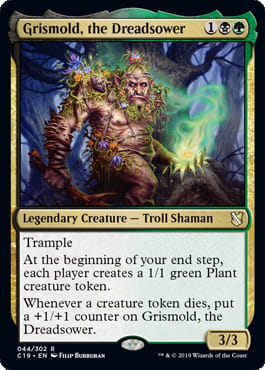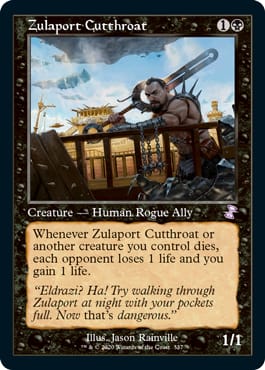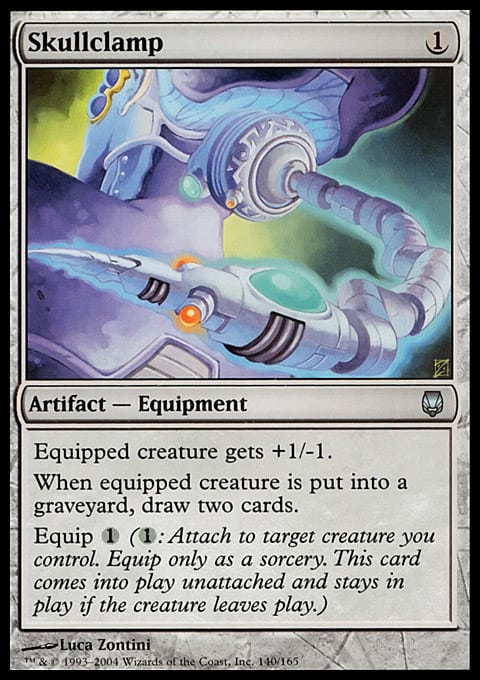The reasons for building a Commander deck are myriad. I'd say the single most common is an actual Legendary creature (or, now, the occasional Planeswalker) striking our fancy. The new set comes out, we scroll through the spoilers, and if something jumps out at us, be it a theme, a bit of flavor, or thoughts of some specific interaction with a card we already have or like, we start putting together a list. Next is probably thematic; we have a favorite tribe or playstyle (I once knew a guy who only played Boros), so we build a deck to fit that theme.
Less common, however, is the forced build, which is precisely where I found myself this week. I'd committed to Golgari, I knew I needed a fourth deck, and yet I didn't have a fully-fleshed out plan when I started, instead deciding to let my gut and research guide me. Here's what I knew:
I needed to build a Golgari deck, and I have a $600 budget.
Well, there are a fair few Golgari commanders, and $600 is plenty of cash to build a really nice Commander deck (sure, you can build them into the thousands even without buying premium foils or whatever, but still, for most of us $600 is a luxury in deck-building). I decided to not worry about the money (if I managed to go over, I could always figure out a cut later) and instead just pick something and let the Commander be the guide I needed. In other words, I didn't get specifically excited about a General I saw, nor did I have a theme in mind. Instead, I had a set of parameters and a call to build a deck. So where did all this wind up? With a deck I'd really like to build in real life.
$600 Grismold | Commander | Mark Wischkaemper
- Commander (1)
- 1 Grismold, the Dreadsower
- Creatures (15)
- 1 Avenger of Zendikar
- 1 Beledros Witherbloom
- 1 Blood Seeker
- 1 Chatterfang, Squirrel General
- 1 Demon of Dark Schemes
- 1 Kaervek, the Spiteful
- 1 Massacre Wurm
- 1 Nadier's Nightblade
- 1 Pitiless Plunderer
- 1 Poison-Tip Archer
- 1 Species Specialist
- 1 Syr Konrad, the Grim
- 1 Tendershoot Dryad
- 1 Vindictive Vampire
- 1 Zulaport Cutthroat
- Planeswalkers (1)
- 1 Tevesh Szat, Doom of Fools
- Instants (12)
- 1 Deadly Rollick
- 1 Golgari Charm
- 1 Heroic Intervention
- 1 Hunter's Insight
- 1 Khalni Ambush // Khalni Territory
- 1 Malakir Rebirth // Malakir Mire
- 1 Oblivion's Hunger
- 1 Return of the Wildspeaker
- 1 Snakeskin Veil
- 1 Szat's Will
- 1 Tragic Slip
- 1 Windgrace's Judgment
- Sorceries (12)
- 1 Agadeem's Awakening // Agadeem, the Undercrypt
- 1 Bala Ged Recovery // Bala Ged Sanctuary
- 1 Casualties of War
- 1 Cultivate
- 1 Explosive Vegetation
- 1 Fungal Sprouting
- 1 Growth Spasm
- 1 In Garruk's Wake
- 1 Kodama's Reach
- 1 Pest Infestation
- 1 Rishkar's Expertise
- 1 Soul's Majesty
- Enchantments (17)
- 1 Attrition
- 1 Bastion of Remembrance
- 1 Deathreap Ritual
- 1 Dictate of Erebos
- 1 Engineered Plague
- 1 Grave Pact
- 1 Illness in the Ranks
- 1 Inner Demon
- 1 Moldervine Reclamation
- 1 Night of Souls' Betrayal
- 1 Parallel Lives
- 1 Path of Discovery
- 1 Pestilence
- 1 Primal Vigor
- 1 Revel in Riches
- 1 Shadows of the Past
- 1 Virulent Plague
- Artifacts (6)
- 1 Darksteel Plate
- 1 Lightning Greaves
- 1 Phyrexian Altar
- 1 Skullclamp
- 1 Spawning Pit
- 1 Whispersilk Cloak
- Lands (36)
- 5 Forest
- 7 Swamp
- 1 Blighted Fen
- 1 Blighted Woodland
- 1 Blooming Marsh
- 1 Bojuka Bog
- 1 Castle Locthwain
- 1 Command Tower
- 1 Foundry of the Consuls
- 1 Grim Backwoods
- 1 High Market
- 1 Hissing Quagmire
- 1 Khalni Garden
- 1 Overgrown Tomb
- 1 Phyrexian Tower
- 1 Reliquary Tower
- 1 Rogue's Passage
- 1 Springjack Pasture
- 1 Tectonic Edge
- 1 Temple of Malady
- 1 Temple of the False God
- 1 Twilight Mire
- 1 Undergrowth Stadium
- 1 Verdant Catacombs
- 1 Woodland Cemetery
- 1 Yavimaya, Cradle of Growth
We've got Golgari Multiplayer Aristokens!
Aristocrats, in its classic form, builds up a board of small creatures which then get sacrificed with some sort of payoff on the 'field. I believe (correct me in the comments if I'm wrong) it's named after Falkenrath Aristocrat, because that was used as a common sacrifice outlet. With a Falkenrath Noble (another Aristocratic creature, if I do say so) on the battlefield, each time a creature died, an opponent lost a life and we gained a life. Do that enough times, and everybody else just dies, no combat, no direct damage spells, just death, while you smile your noble smile. Undying creatures and creatures which left behind tokens when they were killed were great, as were incidental tokens, because you'd get two sacrifices for one card. Double up on your payoffs and it becomes not that difficult to kill off an opponent.
Of course, in Commander we've got multiple opponents to worry about, so we need to adjust our strategy. That Falkenrath Noble, for example, does damage only to target opponent when a creature dies. No good. Take a look, on the other hand, at Zulaport Cutthroat. This limits to only creatures we control, but it does one damage to each opponent. That's better.
Also, there aren't enough Young Wolfs in the world for us to do this with creatures like that. Instead, we're going to make a bunch of tokens, then make our opponents be sad we're making them. That's where Grismold comes in, because he's going to give each of us a Plant. Every. Single. Turn. He's also going to get bigger each time one of them dies, which turns into its own problem.
That lands us at Golgari Multiplayer Aristokens. We're going to make a bunch of tokens, and they're going to die a lot, and each time they die, we're going to get some kind of payoff, ultimately leading to the deaths of our friends sitting at the table.
The curve on this deck is pretty good. We have the most three and 4-drops, then numbers plummet and we only have a few above five. However, this means we really want to hit our land drops up to five, so I'll say it again for the millionth time: we're running 40 lands. Change whatever you want about this deck if you build it, but don't change that. Leave all 40 lands in place.
However, we're also not desperate for a turn one play, so we can run a few lands which come into play tapped. That Hissing Quagmire is worth it for the color fixing. Then again, our budget is such we may as well run our on-color fetch and shocklands. We've also got a Rogue's Passage, which should probably just be in every deck that can support it but is particularly great when we might wind up with a randomly huge Commander. There are also a fair number of lands which make tokens; keep those in mind, because it could be that just sacrificing Foundry of the Consuls will end someone's game.
We do have a touch of Green-based ramp. It's not a ton, but it seems to me to be a good idea. It thins the deck out a bit, and having extra mana (especially when you draw a lot of cards, which this deck does as we'll see) is never bad. However, with more testing it may turn out those cards would be better as something else. We also make some Treasure tokens, which serve as ramp in our case, but it's hard in a build like this to avoid something like Growth Spasm.
There are two ways to draw cards in the deck (assuming you ignore something like Castle Locthwain, which is more incidental, and Skullclamp, which will help us draw to a piece we need if we're not able to kill our tokens reliably). The first is as part of our creature-dying-payoffs, which is cards like Species Specialist (don't necessarily choose Plant), Deathreap Ritual, and Moldervine Reclamation. Assuming people aren't just casting Merciless Eviction or Cyclonic Rift over and over, we should be able to draw a fair amount of cards per turn cycle.
The other way is with one-off card draw spells based on the size of a creature. Because we will often have a fairly large Commander, Rishkar's Expertise, Soul's Majesty, and the fantastic Return of the Wildspeaker all draw us a good amount of cards. We're also running Hunter's Insight, which is a bit more specific but capable of drawing a huge amount. It's possible this would be better as something like Momentous Fall, since it's likely Grismold will become a target of removal before being able to attack and actually get through, but I prefer optimism and really like Hunter's Insight so it goes in.
We are planning to have three ways to potentially win the game. (You never know, though. There could be a super random win with a Tendershoot Dryad and Return of the Wildspeaker on mode two, but we're not trying to make that happen.) Let's break them down.
- Our primary goal is to have tokens be made and die, and kill our opponents along the way.
- Our Commander does a nice job of making tokens, and we've got a few other ways to make tokens. Beledros Witherbloom, for example, gives us a Pest each upkeep, and Tendershoot Dryad does the same but Saprolings. Pest Infestation nicely destroys artifacts and enchantments we don't like, and Fungal Sprouting is in because in the right situation - the right payoff, the right size of Commander, and the right way of getting rid of tokens - it can just win the game. We also have a few ways of doubling up on our tokens, including Chatterfang, Squirrel General (I refuse to run Doubling Season because I hate that card, but it would be good here).
- There are also a few ways of making them die. Probably the best is either Illness in the Ranks or Virulent Plague, both of which make all the tokens we create simply die as soon as they're created. We also have Night of Souls' Betrayal (which has some of the best flavor text I've ever seen), which hits all creatures, so we need to be a bit more careful with when we cast that, since some of our payoffs are also 1/1 creatures. Pestilence is a funny old-school card but works great here, since we can also use it to kill off other stuff and it does damage all on its own, which means we can sometimes just pry a win out of it. Finally, we have our Massacre Wurm effects, where something comes in and just kills all the tokens one time. Massacre Wurm is probably the best one of the bunch, but we have a few of these, since we want to cast our Commander early and we'll need ways to make sure our opponents don't just run us over with the tokens we give them. We also have a couple of actual sacrifice effects (I'm looking at you, Phyrexian Altar) so if we just can't get rid of them, we can simply sweep our entire board out and do a bunch of damage that way.
- Finally, the payoffs. The best one is probably Syr Konrad, the Grim, since he's huge and he can serve as a mana sink if we want to try to knock a nearly-dead opponent out of the game. But there are others, like Poison-Tip Archer (who survives that Massacre Wurm) and Blood Seeker (who doesn't). Bastion of Remembrance is also really, really good, because it doesn't care what happens with creatures. We've got our card draw ones we mentioned earlier, and we have a couple of Grave Pact effects so as our tokens die our opponents also have to sacrifice their other stuff. Finally, a couple of other weird things can happen, like when Pitiless Plunderer is out and we end up making a bunch of Treasure tokens.
- Our second way of winning is with Grismold. If we have three opponents and play out Grismold with a way to kill all the tokens right away (let's say we lucked into an early Illness in the Ranks), Grismold is a 7/7 at the end of the turn he comes out and an 11/11 at the end of the next turn. That's not small, and that's just with his stuff; if we get a few other tokens somehow, it can get out of hand quite quickly. That's why we've got Rogue's Passage and Whispersilk Cloak. If we have a big Commander, it's worth it to remember we might actually be able to kill someone with it almost out of nowhere. This is another example of Fungal Sprouting being potentially amazing; with a 10/10 Grismold, we cast Fungal Sprouting, make 10 tokens, then they all die and we have a 20/20 Grismold.
- The final way is specifically with Revel in Riches. It will be very normal for our deck to kill 10 creatures our opponents control. However, with Pitiless Plunderer out we don't even have to do that, since we'll also make Treasures for our creatures. This means having 10 Treasures at the beginning of our upkeep is well within the realm of possible. This is not a reason to horde Treasure; by all means, use it if it moves the game along - unless you've got Revel in Riches in your hand or on the 'field. With that out, keep that Treasure around and try to win on upkeep.
Our deck should do a pretty reasonable job of keeping creatures off the battlefield, with all the plagues and Wurms and such, but Attrition is a nice way for us to use our random tokens to kill stuff off if we need to, Tragic Slip will almost all be a one-mana -13/13, and Deadly Rollick should normally be free. We've also got In Garruk's Wake, which, in light of all the things that happen when creatures die, should be a pretty fun spell to play. Casualties of War and Windgrace's Judgment both have rather impressive effects and are pretty Golgari-specific, so they get the nod, though feel free to run Putrefy or whatever other spells you'd like in these slots.
We've got a couple of ways to protect our Commander (like Oblivion's Hunger) and Heroic Intervention to keep our whole team alive when someone casts Wrath of God or whatever. Tevesh Szat, Doom of Fools is great mostly because of his first two abilities; ticking him up two is just gravy for us, and ticking him up one triggers our payoffs and draws us even more cards so we can get the pieces we need to assemble a win.
Sometimes players grumble about decks like this, which win without a whole lot of interaction. I'd like to push back on that, though, and point out the value in a deck like this. Most of the time, we're not winning out of the blue - we're winning with incremental damage and value. But more importantly, we will start to push life totals down. I've sat at far too many games of Commander where everyone just built a board state for 8 turns and life totals didn't change. As people start to lose life, however, they start to act, because if they don't, they'll just lose to the incremental life loss. That's good, and should be celebrated.
A few more cards which didn't make the final cut:
- Clackbridge Troll
- Fleshbag Maurader (does this deck want a package of cards like this?)
- Massacre Girl
- Verdant Force
- Path of Discovery
- Seed the Land
- Fungal Rebirth
- Nissa, Voice of Zendikar
- Find // Finality
Total price: $513.36, so pretty well under our $600 budget. Nothing had to be cut to make the budget, either; this is the fully-powered version of the deck.
Now get out there and move a game along with some Aristokens!
Thanks for reading.
























